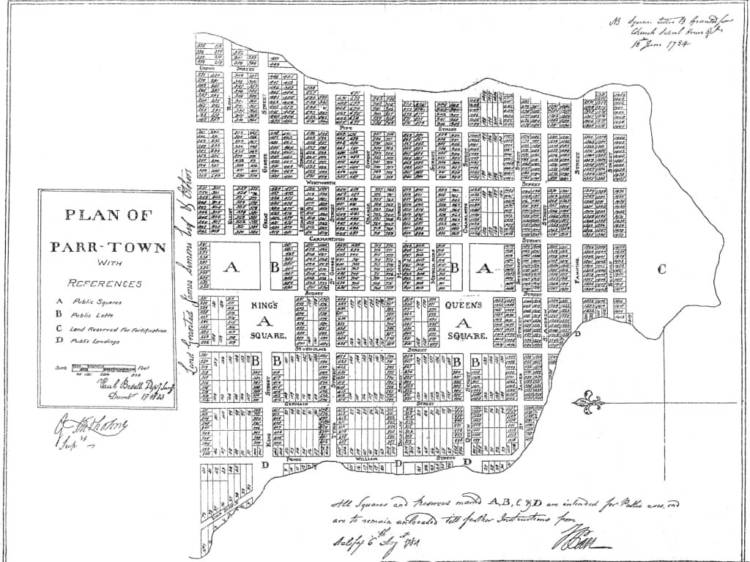
Credit: Heritage Resources, Saint John
The Loyalists were settlers who remained loyal to the British Crown during the American Revolutionary War (1775-1783). Fleeing persecution and facing confiscation of property, many Loyalists arrived on the banks of the Bay of Fundy and laid the foundation for what would become Saint John, Canada’s first incorporated city (1785).
The 14,000 American Loyalists were of many backgrounds: English, Scottish, Irish, German, Dutch, African and Swiss. The traditional day to mark the Loyalist Landing is May 18.
Adam Sheriff Scott’s painting depicts the landing of the Loyalists at the Upper Cove. In 1933, the Lake of the Woods Milling Company presented this painting to the City of Saint John on the 150th anniversary of the Loyalist landing.
Credit: Heritage Resources, Saint John

The Landing
When the Loyalists arrived at Portland Point, they established two settlements, one on either side of the river mouth: Parr-Town on the east and Carleton on the west.
Loyalist Paul Bedell arrived with the Spring Fleet of refugee ships in 1783. Although local lore is that the Loyalists landed at Market Slip, they actually landed at two specific spots along the harbour – the Upper and Lower Coves. While the Lower Cove name still exists, this 1788 drawing shows how Upper Cove was rebuilt to become Market Slip.
Bedell laid out the streets of the Parr-Town peninsula to Lower Cove with military precision. The map’s military grid did not match the rocky topography. Surveyors and builders battled the rock to define lots and construct roads and buildings for the new community, Saint John. This rocky topography is clearly seen in front of the Loyalist house on Union Street.
Credit: Heritage Resources, Saint John

Canada’s First Incorporated City
In 1785, the two settlements were incorporated by charter into the City of Saint John – Canada’s first incorporated city.
Saint John’s strategic location on the Bay of Fundy has made it an important hub of commerce and transportation. Now known as the United Empire Loyalists, this group played a significant role in shaping the city’s early development, contributing to its economic, political and cultural growth by establishing trade routes, founding businesses and building impressive homes and public buildings that still stand today.
Credit: Heritage Resources, Saint John

The Old Public Burial Ground (known today as the Loyalist Burial Ground) had enough space for 12,000 adult burials. It was not the first burial ground in the city and it was closed in 1848 when it became full. It was replaced by the Fernhill Cemetery on Westmorland Road in 1933.
Credit: Heritage Resources, Saint John
Loyalist Heritage
Loyalist heritage is still celebrated in Saint John today, although with less significance than in the past. Only a few historical sites and events remain to commemorate the Loyalists' enduring influence on the region, including:
- The Old Public Burial Ground on Sydney Street, also called the Loyalist Burial Ground where some of the original Loyalist settlers are buried;
- Merrit House at the corner of Union and Germain streets, with the adjoining Queen Ann flag sculpture;
- The Loyalist Rock at Market Square designates the landing of the Loyalists to be of National Historic Significance; and
- The Loyalist Man sign at the Reversing Falls Rapids.
These sites serve as tangible connections to the past and a reminder of the sacrifices and contributions made by these individuals.
Perhaps most importantly, the city’s welcoming nature has lived on as we have faced new eras of rapid growth and development.
The YWCA building is to the left, with the church steeple removed.
The Old Public Burial Ground (known today as the Loyalist Burial Ground) had enough space for 12,000 adult burials. It was not the first burial ground in the city and it was closed in 1848 when it became full. It was replaced by the Fernhill Cemetery on Westmorland Road in 1933.
Credit: Heritage Resources, Saint John








